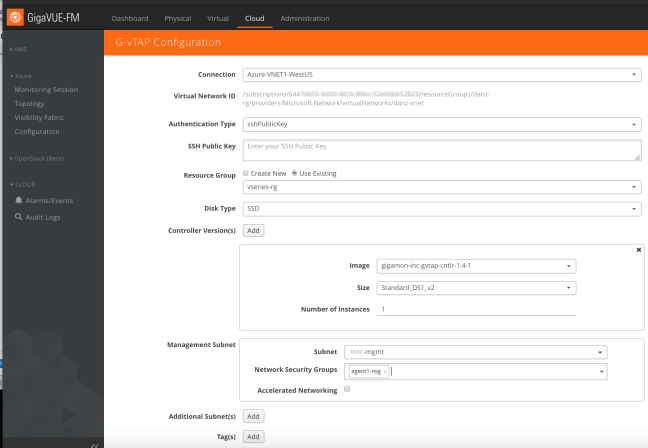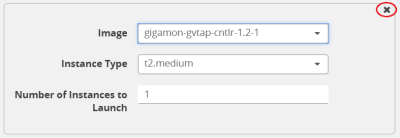Configuring the G-vTAP Controllers
A G-vTAP Controller manages multiple G-vTAP agents and orchestrates the flow of mirrored traffic to GigaVUE V Series nodes.
Note: A single G-vTAP Controller can manage up to 1000 G-vTAP agents. The recommended minimum instance type is Standard_B1s for G-vTAP Controller.
A G-vTAP Controller can only manage G-vTAP agents that has the same version. For example, the G-vTAP Controller v1.3 can only manage G-vTAP agents v1.3. So, if you have G-vTAP agents v1.2 still deployed in the VM machines, you must configure both G-vTAP Controller v1.2 and v1.3.
While configuring the G-vTAP Controllers, you can also specify the tunnel type to be used for carrying the mirrored traffic from the G-vTAP agents to the GigaVUE V Series nodes. The tunnel type can be L2GRE or VXLAN.
To configure the G-vTAP Controllers:
| 1. | Click Cloud in the top navigation link. |
| 2. | Under Azure, click Configuration > G-vTAP Controllers. |
| 3. | Click New. The G-vTAP Configuration page is displayed as shown in Figure 1136: Configuring tG-vTAP Controller . |

Figure 1136: Configuring tG-vTAP Controller
| 4. | Enter or select the appropriate information as shown in Table 1: Fields for G-vTAP Controller Configuration. |
|
Fields |
Description |
||||||||||||
|
Connection |
The name of the Azure connection. Note: For shared controller configuration, you must select the required connection for configuring the G-vTAP Controller. Peering must be active in the selected connection to allow the rest of the connections containing the V-series nodes to be monitored. |
||||||||||||
|
Authentication Type |
Enter the password or SSH Key. |
||||||||||||
|
SSH Public Key |
Paste in the SSH public key. |
||||||||||||
|
Resource Group |
Select Create New or Use Existing. To use Existing, select the existing resource group you wish to use. |
||||||||||||
|
Disk Type |
SSD or HDD (SSD is the default and recommended disk type) |
||||||||||||
|
Controller Version(s) |
The G-vTAP Controller version you configure must always be the same as the G-vTAP agents’ version number deployed in the VM machines. This is because the G-vTAP Controller v1.2 can only manage G-vTAP agents v1.2. Similarly, the G-vTAP Controller v1.3 can only manage G-vTAP agents v1.3. If there are multiple versions of G-vTAP agents deployed in the VM machines, then you must configure multiple versions of G-vTAP Controllers that matches the version numbers of the G-vTAP agents. Note: If there is a version mismatch between G-vTAP controllers and G-vTAP agents, GigaVUE-FM cannot detect the agents in the instances. To add multiple versions of G-vTAP Controllers:
Note: The instance type t2.nano is not supported.
|
||||||||||||
|
Controller Version(s) (continued) |
An older version of G-vTAP Controller can be deleted once all the G-vTAP agents are upgraded to the latest version. To delete a specific version of G-vTAP Controller, click x (delete) next to its G-vTAP Controller image.
Figure 1137: Delete a G-vTAP Controller Version Once you delete a G-vTAP Controller image from the G-vTAP Configuration page, all the G-vTAP Controller instances of that version are deleted from Azure. |
||||||||||||
|
Management Subnet |
Subnet: The subnet that is used for communication between the G-vTAP Controllers and the G-vTAP agents, as well as to communicate with GigaVUE-FM. This is a required field. Every fabric node (both controllers and the nodes) need a way to talk to each other and FM. So they should share at least one management plane/subnet. Network Security Groups: The security group created for the G-vTAP Controller. For example, sg_gvtap-controller. For more information, refer to Network Security Groups. Accelerated Networking: If you select this option, GigaVUE-FM will filter out the supported VM sizes in the list to choose from. Note: Some instance types support this in Azure platform. Refer to Microsoft documentation to learn which ones are supported. |
||||||||||||
|
Additional Subnet(s) |
(Optional) If there are G-vTAP agents on subnets that are not IP routable from the management subnet, additional subnets must be specified so that the G-vTAP Controller can communicate with all the G-vTAP agents. Click Add to specify additional data subnets, if needed. Also, make sure that you specify a list of security groups for each additional subnet. |
||||||||||||
|
Tag(s) |
(Optional) The key name and value that helps to identify the G-vTAP Controller instances in your Azure environment. For example, you might have G-vTAP Controllers deployed in many regions. To distinguish these G-vTAP Controllers based on the regions, you can provide a name that is easy to identify such as us-west-2-gvtap-controllers. To add a tag:
When the G-vTAP Controllers are launched in the VNet, they appear as shown in Figure 1138: G-vTAP Controllers with Custom Tag Name:
|
||||||||||||
|
Use Public IP |
The IP address type. Select one of the following:
|
||||||||||||
|
Agent Tunnel Type |
The type of tunnel used for sending the traffic from G-vTAP agents to GigaVUE V Series nodes. The options are GRE or VXLAN tunnels. If any Windows agents co-exist with Linux agents, VXLAN must be selected. |
||||||||||||
|
G-vTAP Agent MTU (Maximum Transmission Unit) |
The Maximum Transmission Unit (MTU) is the maximum size of each packet that the tunnel endpoint can carry from the G-vTAP agent to the GigaVUE V Series node. For VXLAN, the default value is 1450. The G-vTAP agent tunnel MTU should be 50 bytes less than the agent's destination interface MTU size. |
| 5. | Click Save. |
| 6. | To view the G-vTAP Controllers connection status, click Visibility Fabric > G-vTAP Controllers. |
The G-vTAP Controller instance takes a few minutes to fully initialize. After the initialization is complete, the connection status is displayed as OK. Refer to Figure 1139: G-vTAP Controllers Connection Status.

Figure 1139: G-vTAP Controllers Connection Status
The G-vTAP Controller launch is displayed as an event in the Cloud > Alarms/Events page.

Figure 1140: G-vTAP Controllers Events in Alarms/Events Page
To view the G-vTAP Controllers launched in your VNet:
| 1. | Login to the Azure account and select Services > VM. |
| 2. | In the left navigation pane, click Instances. The G-vTAP Controllers launched in your VNet can be seen as shown Figure 1141: G-vTAP Controllers Configured in Azure. |






